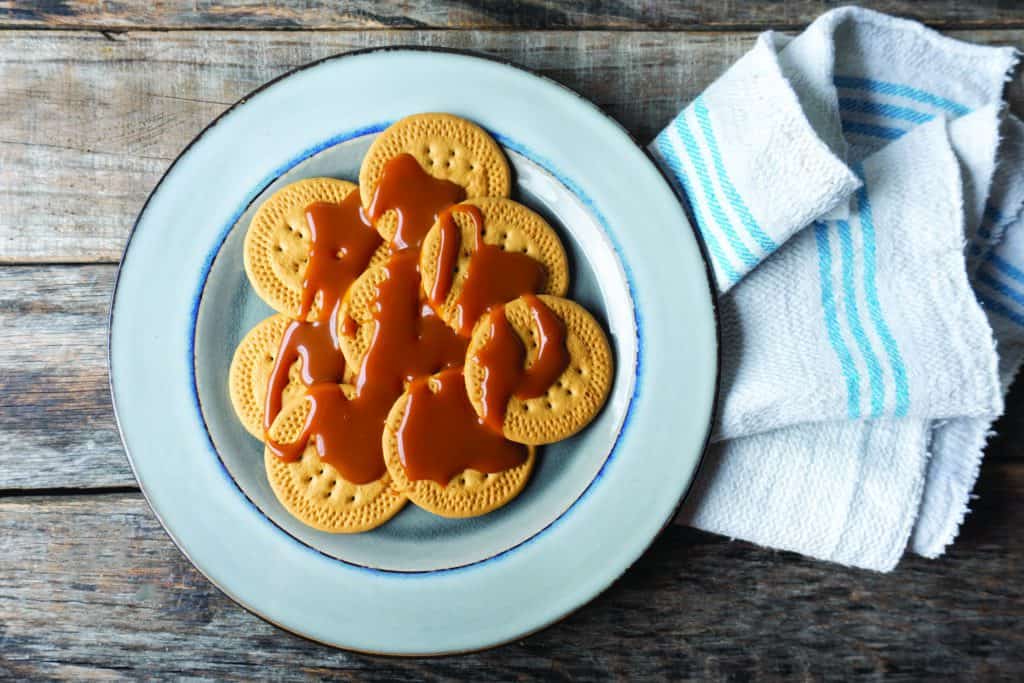
Saturdays in my kitchen are centered around the transistor radio on the windowsill and a project on the stove. Between 10 a.m. and 2 p.m., my local public radio station serves up Wait, Wait, Don’t Tell Me, Planet Money/How I Built This, RadioLab, and the TED and New Yorker Radio Hours.
Listening to the radio (as opposed to podcasts) is old school, and my Saturday kitchen projects trend that way, too. They take hours of time and amounts of patience I don’t typically have during the workweek, things like keeping one eye on a warming pot of DIY yogurt while I wipe down the cabinets with vinegar and water; or making homemade holiday gifts like maple bourbon mustard, rhubarb liqueur, or candied jalapeño and Fresno peppers. This year, it’s jars of cajeta.
Cajeta is a deep, rich goat’s milk caramel sauce first made by accident in Celaya, a town in the central Mexican city state of Guanajuato In 1810, when Mexicans began fighting for independence from Spanish rule, Mexican troops were arriving in Celaya. As the story goes, a local woman was preparing atole—a hot, milky drink made with cinnamon, sugar, and cornstarch—for them when she burnt it. The soldiers still ate it. And loved it.
Commercially produced cajeta has since become a pantry staple in Mexico, where it’s slathered on toast, stuffed into empanadas, poured over ice cream, and used as a dip for both fried plantains and crisp Maria cookies. In the US, it is typically overshadowed by the more widely touted, cow’s milk–based dulce de leche. But cajeta’s flavor, argues Rick Bayless, an American chef and restaurateur who specializes in traditional Mexican cuisine, is fuller, tangier, and more complex due to both the goat’s milk (which is readily available from local goat farms as well as the Whole Foods refrigerator case) and the long simmering time (chemically enabled by a small amount of baking soda in the mix). “The result trades the clamorous solo flavor of caramelized sugar…for the quieter ensemble of browned richness that hints of butterscotch,” writes Bayless in his book Mexico: One Plate at a Time.
A growing number of American goat cheesemakers are producing and selling cajeta as a value-added product at farmers’ markets. But should you find yourself with a quart of goat’s milk and a significant chunk of time on your hands on a Saturday, try making a batch of your own.

Spiced and Salted Cajeta
Ingredients
- 4 cups whole goat’s milk
- 1 cup dark brown sugar
- 1 teaspoon vanilla paste
- 1/2 teaspoon baking soda dissolved in 1.5 teaspoons water
- 1/2 teaspoon kosher salt
- 2 2-inch pieces cinnamon sticks (preferably Mexican canela)
- 2 dried ancho chili peppers
Instructions
- Combine all ingredients in an 8-quart stainless-steel pot and place over medium-high heat. Stir mixture until sugar dissolves. When mixture begins to boil, reduce heat until it is gently boiling. Stir occasionally at first. When it turns golden brown and starts to get thick, stir more frequently. Once mixture is thick and a spoon scraped across the bottom of the pot makes a trail that takes a second to run back in on itself, the cajeta is ready. The whole process can take between 30 minutes and 90 minutes, depending on pot, heat, air temperature, and humidity.
- Remove cinnamon sticks and ancho chilies. Cool cajeta for 30 minutes before transferring it to a glass container fitted with a tight lid. Store in refrigerator for up to a month before it starts to crystalize. You can also store in freezer for up to six months if you smooth a piece of plastic wrap against the surface of the cajeta, leave an inch of clearance at the top of jar, and make sure the cover is secure.




